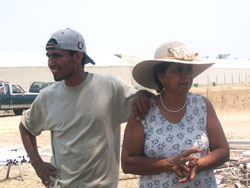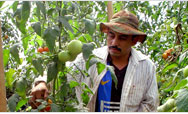You are here » Home » Telling Our Story
Success Story
Small farmers use new irrigation systems that save water and increase income
Conserving Water Increases Yields

| |
Photo: USAID/Virginia Foley
|
|
Rosaura Diaz Aquino and her son Alejandro helped convince farmers to improve irrigation techniques.
Farmer incomes have increased an average of 80 percent, and the level in the Oaxaca Central Valley watershed is returning to a healthy level.
|
Due to dwindling water supplies and expanding farms, farmers in the municipality of San Pablo, Oaxaca, asked Mexico’s National Water Commission for permission to build more wells. But the commission said no.
Drought and wasteful distribution of existing water had dangerously lowered the level of the Central Valley water table, and up to half of the water channeled into the existing canal irrigation system never reached the fields. Adding new water sources without addressing the problem of waste would not create a long-term solution for the region.
In 2003, USAID helped strengthen the Groundwater Technical Committee of the Central Valley, which developed a system of efficient irrigation options for the region. In conjunction with the national and regional water commissions, USAID conducted workshops to educate farmers about how to intensively produce organic vegetables and other basic crops while efficiently using water and energy resources. The National Water Commission contributed half of the costs of constructing the new irrigation systems, and local municipalities and community farmer organizations each contributed 25 percent.
Rosaura Diaz Aquino, a widow and mother of seven, has been involved with the planning from the beginning and is an active member of her community whose opinion commands a great deal of respect. She and her son Alejandro, president of his local farmer cooperative, were influential in convincing Oaxaca’s farmers to invest in the new system.
Farmers who bought into the system now grow beans and fodder in addition to corn and harvest twice a year. Their incomes have increased an average of 80 percent, and the level in the Oaxaca Central Valley watershed is returning to a healthy level.
Print-friendly version of this page (60kb - PDF)
Click here for high-res photo
Back to Top ^ | 

